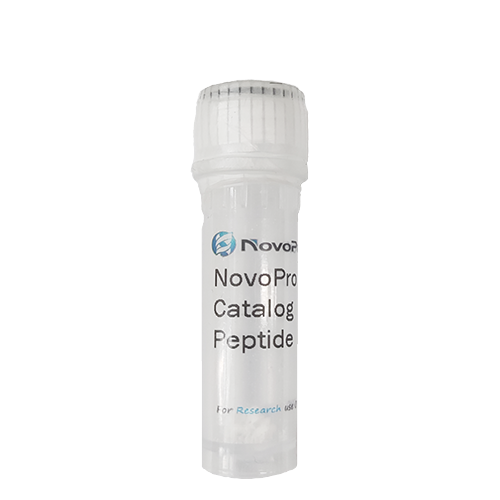Thrombospondin-1 (1016-1023) (human, bovine, mouse) peptide
Not For Human Use, Lab Use Only.
Cat.#: 302561
Special Price 101.20 USD
-
Product Name
Thrombospondin-1 (1016-1023) (human, bovine, mouse) peptide
-
Documents
Batch to batch variation of the purity
-
Sequence Shortening
RFYVVMWK
-
Sequence
H-Arg-Phe-Tyr-Val-Val-Met-Trp-Lys-OH
-
Length (aa)
8
-
Peptide Purity (HPLC)
97.7%
-
Molecular Formula
C56H81N13O10S
-
Molecular Weight
1128.41
-
CAS No.
149234-04-8
-
Source
Synthetic
-
Form
Powder
-
Description
The octapeptide RFYVVMWK constitutes the active sequence within the 30-mer peptide named C4 as it is essential for the cell attachment activity of the TS1 CBD. It supports the attachment of G361 melanoma cells and inhibits their adhesion to the rec CBD of TS1. Moreover, this peptide appears to be highly conserved in all TS1 isoforms, and a related sequence is also present in the fragment F9 of laminin. H-1414 (4N1) has been used as CD47 agonist (see also H-6414).
-
Storage Guidelines
Normally, this peptide will be delivered in lyophilized form and should be stored in a freezer at or below -20 °C. For more details, please refer to the manual: Handling and Storage of Synthetic Peptides
-
References
- M.D.Kosfeld et al., J. Biol. Chem., 266, 24257 (1991)
- M.D.Kosfeld and W.A.Frazier, J. Biol. Chem., 267, 16230 (1992)
- M.D.Kosfeld and W.A.Frazier, J. Biol. Chem., 268, 8808 (1993)
- A.Saumet et al., Blood, 106, 658 (2005)
-
About TFA salt
Trifluoroacetic acid (TFA) is a common counterion from the purification process using High-Performance Liquid Chromatography (HPLC). The presence of TFA can affect the peptide's net weight, appearance, and solubility.
Impact on Net Weight: The TFA salt contributes to the total mass of the product. In most cases, the peptide content constitutes >80% of the total weight, with TFA accounting for the remainder.
Solubility: TFA salts generally enhance the solubility of peptides in aqueous solutions.
In Biological Assays: For most standard in vitro assays, the residual TFA levels do not cause interference. However, for highly sensitive cellular or biochemical studies, please be aware of its presence.
-
Molar Concentration Calculator
-
Dilution Calculator
-
Percent Concentration Calculator
Mass (g) = Concentration (mol/L) × Volume (L) × Molecular Weight (g/mol)
Peptide Property
- Analysed Sequence:H-RFYVVMWK-OH
- Chemical Formula:C56H81N13O10S
- Sequence length:8
- Extinction coefficient:6970 M-1cm-1
- GRAVY:0.31
- Mw average:1128.38
- Theoretical pI:10.39
- Data Source:Peptide Property Calculator
GRAVY = grand average of hydropathy
X: Hydrophobic uncharged residues, like F I L M V W A and P
X: Basic residues, like R K H
X: Acidic residues, like D E
X: Polar uncharged residues, like G S T C N Q and Y
Related Products / Services
• Peptide Services: NovoPro's peptide synthesis services include standard chemical peptide synthesis, peptide modification, peptide libraries, and recombinant peptide expression.
• Standard Peptide Synthesis: NovoPro offers quality peptides at the most competitive prices in the industry, starting at $3.20 per amino acid. NovoPro provides PepBox – Automatic Quote Tool for online price calculation.
• Peptide Modifications: NovoPro offers a wide range of peptide modification services including isotope labeling (2H, 15N, and 13C), multiple disulfide bonds, multiple phosphorylations, KLH, BSA, ovalbumin, amidation, acetylation, biotin, FITC, etc.
Please note: All products are "FOR RESEARCH USE ONLY AND ARE NOT INTENDED FOR DIAGNOSTIC OR THERAPEUTIC USE"

